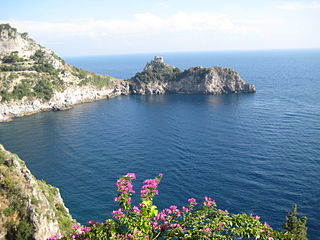
Capri is an island located in the Tyrrhenian Sea off the Sorrento Peninsula, on the south side of the Gulf of Naples in the Campania region of Italy. The main town of Capri that is located on the island shares the name. It has been a resort since the time of the Roman Republic.

A grotto is a natural or artificial cave used by humans in both modern times and antiquity, and historically or prehistorically. Naturally occurring grottoes are often small caves near water that are usually flooded or often flooded at high tide. Sometimes, artificial grottoes are used as garden features. The Grotta Azzurra at Capri and the grotto at Tiberius' Villa Jovis in the Bay of Naples are examples of popular natural seashore grottoes.

Ponza is the largest island of the Italian Pontine Islands archipelago, located 33 km (21 mi) south of Cape Circeo in the Tyrrhenian Sea. It is also the name of the commune of the island, a part of the province of Latina in the Lazio region.
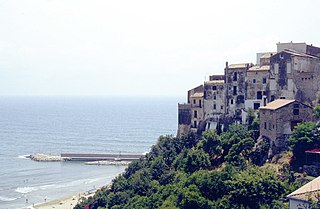
Sperlonga is a coastal town in the province of Latina, Italy, about halfway between Rome and Naples. It is best known for the ancient Roman sea grotto discovered in the grounds of the Villa of Tiberius containing the important and spectacular Sperlonga sculptures, which are displayed in a museum on the site.

A show cave—also called tourist cave, public cave, and, in the United States, commercial cave—is a cave which has been made accessible to the public for guided visits.

Grotta Gigante, also known as Riesengrotte or as Grotta di Brisciachi, is a giant cave on the Italian side of the Trieste Karst (Carso), close to the village of Borgo Grotta Gigante or Briščiki in the municipality of Sgonico. Its central cavern is 107 m (351 ft) high, 65 m (213 ft) wide and 130 m (430 ft) long, putting it in the 1995 Guinness Book of Records as the world's largest show cave. This record was broken in 2010 when La Verna cave in the south west of France was opened to tourists, measuring 255 by 225 by 195 metres.

The Jeita Grotto is a system of two separate, but interconnected, karstic limestone caves spanning an overall length of nearly 9 kilometres (5.6 mi). The caves are situated in the Nahr al-Kalb valley within the locality of Jeita, 18 kilometres (11 mi) north of the Lebanese capital Beirut. Though inhabited in prehistoric times, the lower cave was not rediscovered until 1836 by Reverend William Thomson; it can only be visited by boat since it channels an underground river that provides fresh drinking water to more than a million Lebanese.
The island of Capri is situated in the Gulf of Naples, between the Italian Peninsula and the islands of Procida and Ischia. Made of limestone, its lowest part is at the center, while its sides are high and mostly surrounded by steep precipices, which contain numerous caves. Its topography is dominated by the slopes of the Monte Solaro in the west and Monte San Michele in the east.
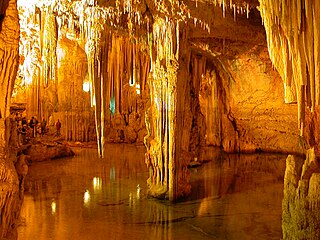
Neptune's Grotto is a stalactite cave near the town of Alghero on the island of Sardinia, Italy. The cave was discovered by local fishermen in the 18th century and has since developed into a popular tourist attraction. The grotto gets its name from the Roman god of the sea, Neptune.

The Villa di Castello, near the hills bordering Florence, Tuscany, central Italy, was the country residence of Cosimo I de' Medici, Grand Duke of Tuscany (1519-1574). The gardens, filled with fountains, statuary, and a grotto, became famous throughout Europe. The villa also housed some of the great art treasures of Florence, including Sandro Botticelli's Renaissance masterpieces The Birth of Venus and Primavera. The gardens of the Villa had a profound influence upon the design of the Italian Renaissance garden and the later French formal garden.

Blue Cave is the most celebrated attraction of the Greek island of Kastellorizo, and is a sufficient reason to visit the island. The cave lies on the southeast coast of the island, and is named by the inhabitants Phókiali.
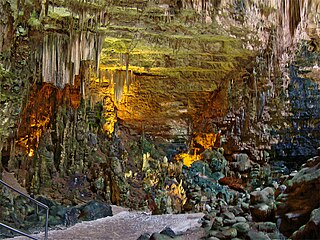
The Castellana Caves are a karst cave system located in the municipality of Castellana Grotte, in the Metropolitan City of Bari, Apulia, southern Italy.

The Blue Grotto refers to a number of sea caverns on the south east coast of Malta, a short distance from the fishing harbour limits of Wied iż-Żurrieq, Malta. Wied iz-Zurrieq, the blue grotto and neighboring caves, are all located within the Qrendi village confines, per Local Council Act 1993 and a 1910 legal dispute between the villages of Qrendi and Zurrieq over their jurisdiction, which ruled in favour of Qrendi.
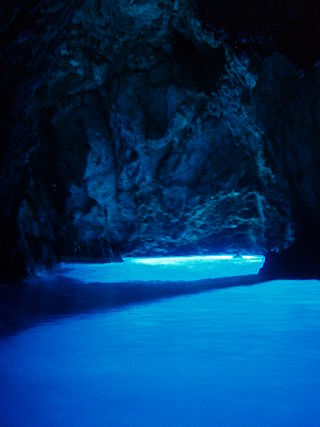
The Blue Grotto or Blue Cave, is a waterlogged sea cave located in a small bay called Balun, on the east side of the island of Biševo and about 4.5 nautical miles (8.3 km) from Komiža, in the Croatian Adriatic. It is situated in the central Dalmatian archipelago, 5 km south-west of the island of Vis. The grotto is one of the best known natural beauty spots on the Adriatic and a popular show cave because of the glowing blue light that appears at certain times of day.
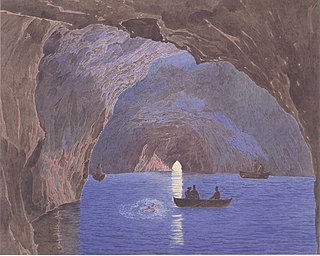
Entdeckung der blauen Grotte auf der Insel Capri is an 1838 book by German writer and painter August Kopisch in which he describes his 1826 rediscovery of the Blue Grotto in Capri together with his friend Ernest Fries. The book sparked interest in the island among the Romantics, particularly in Germany, and introduced the world to the Blue Grotto, both as a tourist sight and as an iconic symbol for the island.

The Cave of Dogs is a cave near Naples, Italy. Volcanic gases seeping into the cave give the air inside a high concentration of carbon dioxide. Dogs held inside would faint; at one time this was a tourist attraction.
















